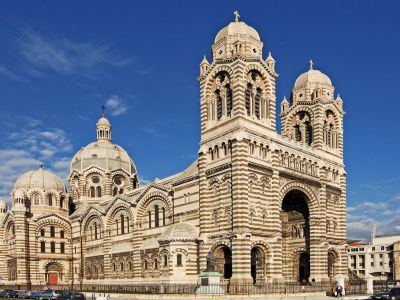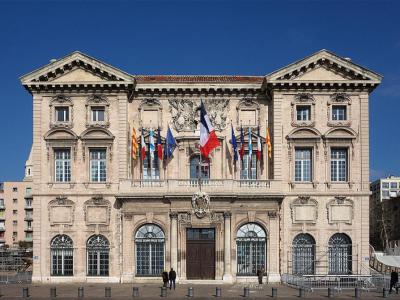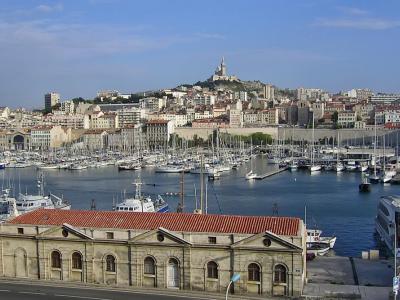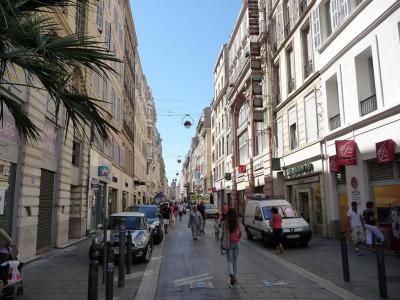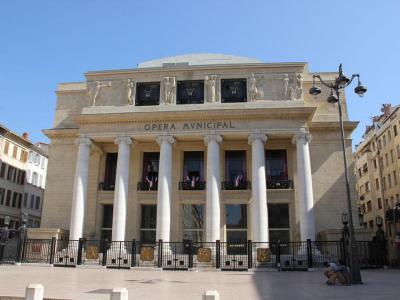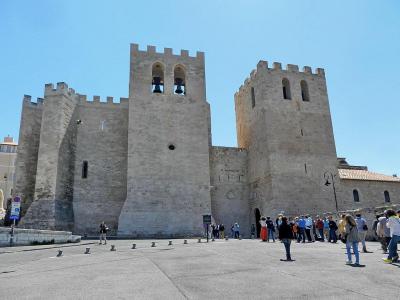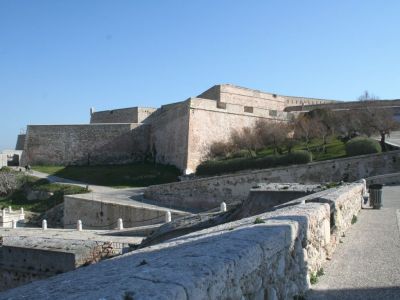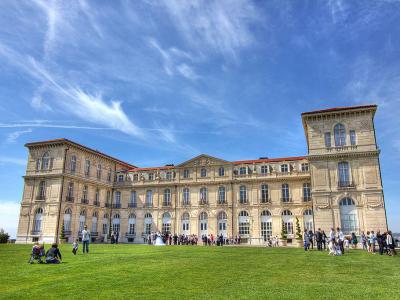
Marseille Introduction Walking Tour (Self Guided), Marseille
Marseille was created by immigrants from all around the Mediterranean basin even before the Phocaeans. In about 620 BC a Greek Phoenician galley rowed into a small outlet called Lacydon Creek, looking for trade. They found it. Ligurians occupied the land, and being sort of Greek themselves, they didn't mind doing business.
The leader of the galley people was one called Protis. Protis was looking for a likely place to open a business. The harbor with its surrounding hills was perfect. Now he needed to get married. He chose Gyptis, daughter of Good King Naan, a local king. Or some say she chose him. And the story of Massalia began.
Marseille's openness to the sea is the the secret of its power and prosperity. For 2,000 years, the new folks just kept on coming. Traders, fisherfolk, kings, Romans, Arabs, Goths, more traders, poets and painters landed at the Old Port. Protis knew a good thing when he saw it. Marseille survived everything, even the Nazis.
Now, we will explore. We have landed at the Quai de Belges, where the fishing boats dock in the morning. The fish market opens at eight in the morning. Stroll along the Quai and see the catch of the day. Turn around and see the Hotel de Ville, the city hall since 1656.
Leaving the Old Port, we can venture on the Canebiere Avenue, the St. Ferreol Street. The city is marked by "pedestrianized" squares. Visit the Saint-Victor Abbey, the forts St. Nicolas and St. Jean, the Pharo Palace (Napoleon III did NOT sleep here). See all these. Grand and compact, Marseille awaits. A great ancient city available to you as it was to Protis.
The leader of the galley people was one called Protis. Protis was looking for a likely place to open a business. The harbor with its surrounding hills was perfect. Now he needed to get married. He chose Gyptis, daughter of Good King Naan, a local king. Or some say she chose him. And the story of Massalia began.
Marseille's openness to the sea is the the secret of its power and prosperity. For 2,000 years, the new folks just kept on coming. Traders, fisherfolk, kings, Romans, Arabs, Goths, more traders, poets and painters landed at the Old Port. Protis knew a good thing when he saw it. Marseille survived everything, even the Nazis.
Now, we will explore. We have landed at the Quai de Belges, where the fishing boats dock in the morning. The fish market opens at eight in the morning. Stroll along the Quai and see the catch of the day. Turn around and see the Hotel de Ville, the city hall since 1656.
Leaving the Old Port, we can venture on the Canebiere Avenue, the St. Ferreol Street. The city is marked by "pedestrianized" squares. Visit the Saint-Victor Abbey, the forts St. Nicolas and St. Jean, the Pharo Palace (Napoleon III did NOT sleep here). See all these. Grand and compact, Marseille awaits. A great ancient city available to you as it was to Protis.
How it works: Download the app "GPSmyCity: Walks in 1K+ Cities" from Apple App Store or Google Play Store to your mobile phone or tablet. The app turns your mobile device into a personal tour guide and its built-in GPS navigation functions guide you from one tour stop to next. The app works offline, so no data plan is needed when traveling abroad.
Marseille Introduction Walking Tour Map
Guide Name: Marseille Introduction Walking Tour
Guide Location: France » Marseille (See other walking tours in Marseille)
Guide Type: Self-guided Walking Tour (Sightseeing)
# of Attractions: 9
Tour Duration: 2 Hour(s)
Travel Distance: 3.8 Km or 2.4 Miles
Author: dana
Sight(s) Featured in This Guide:
Guide Location: France » Marseille (See other walking tours in Marseille)
Guide Type: Self-guided Walking Tour (Sightseeing)
# of Attractions: 9
Tour Duration: 2 Hour(s)
Travel Distance: 3.8 Km or 2.4 Miles
Author: dana
Sight(s) Featured in This Guide:
- Cathédrale de la Major (Marseille Cathedral)
- Hotel de Ville (City Hall)
- Vieux-Port (Old Port)
- Rue St. Ferréol (St. Ferréol Street)
- Opéra Municipal (Municipal Opera House)
- Cours Honoré-d'Estienne-d'Orves (Henri Estienne d'Orves Square)
- Abbaye Saint-Victor (Saint-Victor Abbey)
- Fort St. Nicholas
- Palais du Pharo (Pharo Palace)
1) Cathédrale de la Major (Marseille Cathedral) (must see)
Also known as Cathedrale Sainte-Marie-Majeure de Marseille, it is actually two cathedrals, old and new. In the latter part of the 19th century Napoleon III, Emperor of France, decided to replace the 12th century provencal romanesque cathedral ("Vielle Major"). He had it demolished, all but the choir and one bay of the nave.
He spared the remnant when the outraged population demonstrated against the change. The new cathedral ("Nouvelle Major") is a massive Romanesque-Byzantine Revival structure. Towering over the waterfront, it is 469 feet long, and the main cupola is 231 feet high. It can hold up to some 3,000 souls.
It is located on the Plaza Major. The facade is formed of two different types of stone tile, giving the effect of horizontal bars of color. The locals were reminded of bedtime attire and they often refer to the cathedral as "the Pajamas", no offense intended. The interior features Carrera marble, Tunisian onyx, and Venetian mosaics.
The remains of the old 12th century cathedral huddle alongside La Major. There is not a lot left of it after Napoleon III's smashing venture. There is a chansel and an apse with smaller apses on the side. The vault is cylindrical with an eight-sided cupola above the transept and a seven-sided cupola above the cross of the transept.
Why You Should Visit:
This is an awesome structure. It declares not so much spiritual glory as it does the past glory of Imperial France. Dominating all around it, it declares power forgotten but never outdone. And besides, admission is free.
He spared the remnant when the outraged population demonstrated against the change. The new cathedral ("Nouvelle Major") is a massive Romanesque-Byzantine Revival structure. Towering over the waterfront, it is 469 feet long, and the main cupola is 231 feet high. It can hold up to some 3,000 souls.
It is located on the Plaza Major. The facade is formed of two different types of stone tile, giving the effect of horizontal bars of color. The locals were reminded of bedtime attire and they often refer to the cathedral as "the Pajamas", no offense intended. The interior features Carrera marble, Tunisian onyx, and Venetian mosaics.
The remains of the old 12th century cathedral huddle alongside La Major. There is not a lot left of it after Napoleon III's smashing venture. There is a chansel and an apse with smaller apses on the side. The vault is cylindrical with an eight-sided cupola above the transept and a seven-sided cupola above the cross of the transept.
Why You Should Visit:
This is an awesome structure. It declares not so much spiritual glory as it does the past glory of Imperial France. Dominating all around it, it declares power forgotten but never outdone. And besides, admission is free.
2) Hotel de Ville (City Hall)
The Hotel de Ville is, of course, not a hotel. It is the City Hall of Marseille. Built in 1656, it has been Marseille's civic center ever since. It replaced the "Maison de Ville", which had served the same purpose since the thirteenth century.
The Hotel de Ville is a pink stone building constructed in the Genoan Baroque style. It fronts the harbor's edge of the Old Port of Marseille. It has an ornate facade, designed by Gaspard Puget. The facade is adorned with sculptures and flags.
Above the main entrance is the seal of the city, designed by Pierre Puget, yes, Pierre is related to Gaspard. They were brothers. Pierre was a favorite of Louis XIV, so naturally there is a bust of his royal highness. He perches high above all else, overseeing the bustling harbor and the boulevard below.
The kings did not survive the 18th century. However the Hotel de Ville did survive. It survived regimes, revolutions (France has had more than one), and even World War II.
It is often referred to as "La Loge", from the Italian word "Loggia" because of it's Baroque style. Around the back of the building is a bridge connecting the two main levels of the Hotel.
In the 18th century the floors were disconnected to separate the nobility, who occupied the top floor, and the merchants and other lesser souls who used the ground floor. The bridge now reunites the classes, which is a sign of progress!
The Hotel de Ville is a pink stone building constructed in the Genoan Baroque style. It fronts the harbor's edge of the Old Port of Marseille. It has an ornate facade, designed by Gaspard Puget. The facade is adorned with sculptures and flags.
Above the main entrance is the seal of the city, designed by Pierre Puget, yes, Pierre is related to Gaspard. They were brothers. Pierre was a favorite of Louis XIV, so naturally there is a bust of his royal highness. He perches high above all else, overseeing the bustling harbor and the boulevard below.
The kings did not survive the 18th century. However the Hotel de Ville did survive. It survived regimes, revolutions (France has had more than one), and even World War II.
It is often referred to as "La Loge", from the Italian word "Loggia" because of it's Baroque style. Around the back of the building is a bridge connecting the two main levels of the Hotel.
In the 18th century the floors were disconnected to separate the nobility, who occupied the top floor, and the merchants and other lesser souls who used the ground floor. The bridge now reunites the classes, which is a sign of progress!
3) Vieux-Port (Old Port) (must see)
The Old Port of Marseille is located on the Canebiere, the "Main Street" of the old city. Yes, the city is old, like very old. Originally used as a seaport of the ancient Phoenicians, a sea-faring nation that had colonies throughout the Mediterranean.
The old port itself was established in 600 BCE by Greek settlers from Phocaea. Shipyards were established by both Louis XII and Louis XIII during the fifteenth and sixteenth centuries. Louis XIV erected the forts of Saint Jean and Saint Nicolas at the harbor's entrance. Apparently, in France, there has been no dearth of Louis.
In it's busy heyday, in the 1850s, the port was host to as many as 18,000 merchant ships a year. This amount of traffic rivaled that of major European ports like Liverpool or Le Havre. With the advent of steam the shallow depth of the harbor created problems for the deeper draft steamships.
In World War II German occupation forces, with the help, unfortunately, of the French police destroyed most of the harbor to deny its use by the allies. This became known as the "Battle of Marseille".
The Old Port today serves mainly as a marina. It is a terminal for local boats and ferries. It also has a fish market. It stars in quite a few movies, such as, The Count of Monte Cristo, featuring the Chateau d'If, and The French Connection and French Connection II, featuring Gene Hackman and Tony LoBianco.
Why You Should Visit:
The Old Port has been thoroughly renovated and it is mostly open to pedestrians. The harbor and the many historical sights and buildings can be seen when walking along the Canebiere.
The old port itself was established in 600 BCE by Greek settlers from Phocaea. Shipyards were established by both Louis XII and Louis XIII during the fifteenth and sixteenth centuries. Louis XIV erected the forts of Saint Jean and Saint Nicolas at the harbor's entrance. Apparently, in France, there has been no dearth of Louis.
In it's busy heyday, in the 1850s, the port was host to as many as 18,000 merchant ships a year. This amount of traffic rivaled that of major European ports like Liverpool or Le Havre. With the advent of steam the shallow depth of the harbor created problems for the deeper draft steamships.
In World War II German occupation forces, with the help, unfortunately, of the French police destroyed most of the harbor to deny its use by the allies. This became known as the "Battle of Marseille".
The Old Port today serves mainly as a marina. It is a terminal for local boats and ferries. It also has a fish market. It stars in quite a few movies, such as, The Count of Monte Cristo, featuring the Chateau d'If, and The French Connection and French Connection II, featuring Gene Hackman and Tony LoBianco.
Why You Should Visit:
The Old Port has been thoroughly renovated and it is mostly open to pedestrians. The harbor and the many historical sights and buildings can be seen when walking along the Canebiere.
4) Rue St. Ferréol (St. Ferréol Street)
Ferreol, or Ferreolus of Uzes was the Bishop of Uzes and possibly of Nimes, France. This was quite awhile ago. He died in 581, CE. After he had passed, he became Saint Ferreol. Among subsequent honors that may have been awarded him there is the Rue Saint Ferreol in Marseille, France.
There, in one of the oldest cities in Europe, is a street famous for shopping, shopping of all kinds. Why name a commercial street after an ancient saint? Well, why not?
Saint Ferreol must have given his blessing to the street named after him. The place is thriving. It is all foot traffic there. Wander up and down the street. It is busy, and, like La Canebriere, a friendly shopping street. There are boutiques, galleries, including Galleries Lafayette, H&M, Seploc, Zara, Virgin and many others.
One can find the same chain stores as in Toronto, Rome, or New York, but everything one might be looking for is very likely here. The street is not super clean, but Saint Ferreol doesn't seem to mind.
There, in one of the oldest cities in Europe, is a street famous for shopping, shopping of all kinds. Why name a commercial street after an ancient saint? Well, why not?
Saint Ferreol must have given his blessing to the street named after him. The place is thriving. It is all foot traffic there. Wander up and down the street. It is busy, and, like La Canebriere, a friendly shopping street. There are boutiques, galleries, including Galleries Lafayette, H&M, Seploc, Zara, Virgin and many others.
One can find the same chain stores as in Toronto, Rome, or New York, but everything one might be looking for is very likely here. The street is not super clean, but Saint Ferreol doesn't seem to mind.
5) Opéra Municipal (Municipal Opera House)
The Municipal Opera House opened its doors in 1924. It replaced The Grand-Theatre or Salle Bauveau, constructed in 1787, which had previously replaced the original house of 1685.
The Grand Theatre enjoyed great success after the revolution and many great operas opened there. In November 1919, some years following the introduction of electricity, the theatre burned almost to the ground, leaving only the outer shell and one exterior colonnade.
The present opera house seats 1,800 in an urn-shed auditorium. It also has boxes, balconies and a gallery. It is designed by the architects Ebrard, Castel, and Raymond. it has been described as "an Art Deco temple".
Among famous artists who have debuted at this house are Alfredo Kraus, Placido Domingo, and Renata Scotto. The audiences have a reputation being very critical. Most of these critics can be found in the topmost gallery. They are commonly referred to as "the gods".
The Grand Theatre enjoyed great success after the revolution and many great operas opened there. In November 1919, some years following the introduction of electricity, the theatre burned almost to the ground, leaving only the outer shell and one exterior colonnade.
The present opera house seats 1,800 in an urn-shed auditorium. It also has boxes, balconies and a gallery. It is designed by the architects Ebrard, Castel, and Raymond. it has been described as "an Art Deco temple".
Among famous artists who have debuted at this house are Alfredo Kraus, Placido Domingo, and Renata Scotto. The audiences have a reputation being very critical. Most of these critics can be found in the topmost gallery. They are commonly referred to as "the gods".
6) Cours Honoré-d'Estienne-d'Orves (Henri Estienne d'Orves Square)
Marseille is one of the great cities of the world to walk in. Walk about in the heart of the city. There you will find a "pedestrianized" square close to the Old Port, set aside with tourists in mind. It is the cours Honore-d'Estienne-d'Orves, named for a French naval officer executed by German occupation forces in 1941. A hero of France.
In 1488 King Charles VIII established in Marseille a base for galleys of the French royal navy. Ultimately the base held a royal garrison and about 8,000 prisoners to row the galleys. Yes, that's where Jean Val Jean (Les Miserables) got his start.
When galleys went out of fashion the base was turned over to the city. Only arsenals 23 and 25 remain in the cours. They have been transformed into a library-gallery-boutique-restaurant known as "Les Asenaux".
The work of urban designer and planner Charlie Bove, the square was opened in 1989. Lined with shops, restaurants and cafes, bars, boutiques and galleries, it is a home for art festivals and fairs and an ice rink.
Among the many Mediterranean cuisines featured here is that of Provence. How about fish from the fish market of neighboring Old Port? Ah, wait! How about a traditional Provencal bouillabaisse, why not?
In 1488 King Charles VIII established in Marseille a base for galleys of the French royal navy. Ultimately the base held a royal garrison and about 8,000 prisoners to row the galleys. Yes, that's where Jean Val Jean (Les Miserables) got his start.
When galleys went out of fashion the base was turned over to the city. Only arsenals 23 and 25 remain in the cours. They have been transformed into a library-gallery-boutique-restaurant known as "Les Asenaux".
The work of urban designer and planner Charlie Bove, the square was opened in 1989. Lined with shops, restaurants and cafes, bars, boutiques and galleries, it is a home for art festivals and fairs and an ice rink.
Among the many Mediterranean cuisines featured here is that of Provence. How about fish from the fish market of neighboring Old Port? Ah, wait! How about a traditional Provencal bouillabaisse, why not?
7) Abbaye Saint-Victor (Saint-Victor Abbey) (must see)
South of the Old Port, overlooking the sea, is the Abbaye Saint Victor. The abbey has always been on that spot, more or less since the year 415. Tradition has it that the abbey was founded by the monk John Cassian. Some say the crypt of the abbey contains relics from Saint Victor or evidence of a quarry dating back to ancient Greece.
Cassian founded two monasteries, one for men and one for women on opposite sides of the old harbor. Both were destroyed by Saracen raiders in the 8th or 9th centuries. In 977 monastic life at Saint Victor's began again. The abbey thrived more or less until 1794, when in the wake of the revolution it was stripped of all its treasures.
At various stages it became a warehouse, prison and a barracks. It made a comeback in Napoleon's day and it was designated a minor basilica after restoration in 1934 by Pope Pius XI.
Let us descend now, to the ancient crypt of Saint Victor. What will we find? Tombs. Tombs of saints and some bishops who were also saints. Also there are to be found ancient pagan sarcophagi. Soft music in the background accompanies visitors.
Ascending to the crenelated towers of the abbey we get a stunning view of the harbor and the sea. The abbey is perched on a hill close by Fort Saint Nicolas. The monks liked to catch sight of the Saracens and Vikings as far out to sea as possible.
Each year at Candlemas there is a pilgrimage from the Old Port to the abbey. Early in the morning a procession leaves the Old Port and heads to the Abbey. The black Madonna from the crypt is wrapped in her green cloak and presented to the public in the square in front of the abbey where she receives the blessing of the Bishop.
Why You Should Visit:
The abbey, and especially the crypt of the abbey will take you well back in time when Europe was still being formed.
Tip:
It is worth paying the small fee to go downstairs and visit the wonderful crypt – it is like entering another world!
Cassian founded two monasteries, one for men and one for women on opposite sides of the old harbor. Both were destroyed by Saracen raiders in the 8th or 9th centuries. In 977 monastic life at Saint Victor's began again. The abbey thrived more or less until 1794, when in the wake of the revolution it was stripped of all its treasures.
At various stages it became a warehouse, prison and a barracks. It made a comeback in Napoleon's day and it was designated a minor basilica after restoration in 1934 by Pope Pius XI.
Let us descend now, to the ancient crypt of Saint Victor. What will we find? Tombs. Tombs of saints and some bishops who were also saints. Also there are to be found ancient pagan sarcophagi. Soft music in the background accompanies visitors.
Ascending to the crenelated towers of the abbey we get a stunning view of the harbor and the sea. The abbey is perched on a hill close by Fort Saint Nicolas. The monks liked to catch sight of the Saracens and Vikings as far out to sea as possible.
Each year at Candlemas there is a pilgrimage from the Old Port to the abbey. Early in the morning a procession leaves the Old Port and heads to the Abbey. The black Madonna from the crypt is wrapped in her green cloak and presented to the public in the square in front of the abbey where she receives the blessing of the Bishop.
Why You Should Visit:
The abbey, and especially the crypt of the abbey will take you well back in time when Europe was still being formed.
Tip:
It is worth paying the small fee to go downstairs and visit the wonderful crypt – it is like entering another world!
8) Fort St. Nicholas
"Why are you pointing that gun at me? No, I mean guns, lots of guns pointed at the town, not out to sea. What will you do for an attack by sea? You're not afraid of Saracens, or Vikings, or the British?"
The year is 1664 and King Louis XIV has completed the Fort Saint Nicolas in Marseille, and he's open for business. He's ready for anything. There's something odd, though. The citizens have noticed all those guns are pointed at the town, NOT the sea.
Mon Dieu! The neighboring fort, Fort Saint Jean, also is aiming at the town. And with good reason, from the King's point of view. The citizens of Marseille are in rebellion against the governor and the guns are a dose of reality.
During the 1700s the fort was used mainly as a military prison. During the revolution the people of Marseille finally had a shot at Fort Saint Nicolas and they tried to sack it. However the Assembee National stopped the sacking after a month. Apparently the new government thought the fort/prison had its uses.
The fort was restored in the nineteenth century. The new parts are grey and this makes it easy to distinguish new from old. The old parts are red. The fort is also divided in two parts. The seaward part is garrisoned and used mainly as an officers mess. Only the landward side is open to the public. This is the higher part. The view is fantastic.
The year is 1664 and King Louis XIV has completed the Fort Saint Nicolas in Marseille, and he's open for business. He's ready for anything. There's something odd, though. The citizens have noticed all those guns are pointed at the town, NOT the sea.
Mon Dieu! The neighboring fort, Fort Saint Jean, also is aiming at the town. And with good reason, from the King's point of view. The citizens of Marseille are in rebellion against the governor and the guns are a dose of reality.
During the 1700s the fort was used mainly as a military prison. During the revolution the people of Marseille finally had a shot at Fort Saint Nicolas and they tried to sack it. However the Assembee National stopped the sacking after a month. Apparently the new government thought the fort/prison had its uses.
The fort was restored in the nineteenth century. The new parts are grey and this makes it easy to distinguish new from old. The old parts are red. The fort is also divided in two parts. The seaward part is garrisoned and used mainly as an officers mess. Only the landward side is open to the public. This is the higher part. The view is fantastic.
9) Palais du Pharo (Pharo Palace) (must see)
No surprise, the promontory on which the Pharo Palace was built is called "Pharo" after the bay to the west. The hill used to be called "Tete de More". The palace itself is a massive building located at the mouth of the Old Port.
This was intended to be an imperial residence. Prince Louis-Napoleon commissioned architect Vaucher in 1852 to find a location and make plans. The project was taken over by Napoleon III's architect, Lefuel and the city donated the land.
Napoleon III never got a chance to stay there before he died and the Empress Eugenie gave the Pharo back to the city of Marseille. In 1904 The palace was made over to be a medical school.
The palace currently hosts meetings, fairs and conferences. The original interior spaces and the extension can hold up to 2500 people. After 1870 imperial ornaments on the outside of the building were removed so that no indication of the empire would remain.
This was intended to be an imperial residence. Prince Louis-Napoleon commissioned architect Vaucher in 1852 to find a location and make plans. The project was taken over by Napoleon III's architect, Lefuel and the city donated the land.
Napoleon III never got a chance to stay there before he died and the Empress Eugenie gave the Pharo back to the city of Marseille. In 1904 The palace was made over to be a medical school.
The palace currently hosts meetings, fairs and conferences. The original interior spaces and the extension can hold up to 2500 people. After 1870 imperial ornaments on the outside of the building were removed so that no indication of the empire would remain.
Walking Tours in Marseille, France
Create Your Own Walk in Marseille
Creating your own self-guided walk in Marseille is easy and fun. Choose the city attractions that you want to see and a walk route map will be created just for you. You can even set your hotel as the start point of the walk.
Historical Churches Walking Tour
Marseille's religious scene, albeit diverse, is dominated by Christianity. The Christian presence in the city dates back to ancient times, making it an integral part of local identity. The vibrant Mediterranean port city also has been a significant pilgrimage destination.
The majority of Christians in Marseille are Roman Catholics, whose prevalence is manifested in the form of multiple... view more
Tour Duration: 2 Hour(s)
Travel Distance: 3.6 Km or 2.2 Miles
The majority of Christians in Marseille are Roman Catholics, whose prevalence is manifested in the form of multiple... view more
Tour Duration: 2 Hour(s)
Travel Distance: 3.6 Km or 2.2 Miles
Food and Shopping Walk
Shopping in Marseille is a great way to mingle with the locals and immerse in new tastes, scents and customs. As with so much else in this melting-pot of a city, the top-of-the-range stores here rub shoulders with the funky little boutiques, high-street chains with scruffy discount outlets or traditional family groceries and bakeries.
Marseille doesn't have a flagship thoroughfare as such,... view more
Tour Duration: 1 Hour(s)
Travel Distance: 1.8 Km or 1.1 Miles
Marseille doesn't have a flagship thoroughfare as such,... view more
Tour Duration: 1 Hour(s)
Travel Distance: 1.8 Km or 1.1 Miles
Marseille's Old Town
Marseille's Panier (Old Town) is full of history. The nick "Panier" means "basket" and it comes from the 17th-century inn, Le Logis du Panier, that once stood on today's rue du Panier.
Over the course of centuries the cobblestone streets of Marseille's Old Town had been a haven for refugees, criminals, and prostitutes, as well as Resistance fighters, Jews and... view more
Tour Duration: 2 Hour(s)
Travel Distance: 2.9 Km or 1.8 Miles
Over the course of centuries the cobblestone streets of Marseille's Old Town had been a haven for refugees, criminals, and prostitutes, as well as Resistance fighters, Jews and... view more
Tour Duration: 2 Hour(s)
Travel Distance: 2.9 Km or 1.8 Miles
The Most Popular Cities
/ view all
